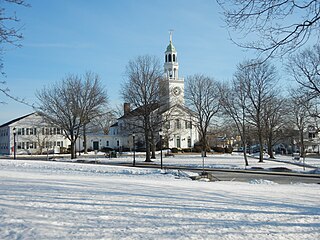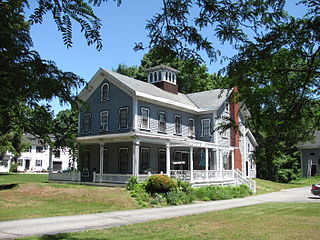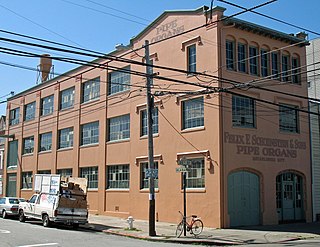
Reading is a town in Middlesex County, Massachusetts, United States, 16 miles (26 km) north of central Boston. The population was 25,518 at the 2020 census.

Mechanics Hall is a concert hall in Worcester, Massachusetts. It was built in 1857 in the Renaissance Revival style and restored in 1977. Built as part of the early nineteenth-century worker's improvement movement, it is now a concert and performing arts venue ranked as one of the top four concert halls in North America and in the top twelve between Europe and the Americas. It also houses a recording studio.

The Theodore Baird Residence, also known as Baird House, is a suburban house designed by American architect Frank Lloyd Wright, and located at 38 Shays Street in Amherst, Massachusetts, United States. It is the only Wright design in Massachusetts.
The British Institute of Organ Studies (BIOS) is a British organisation and registered charity which aims to promote study and appreciation of all aspects of the pipe organ. Further, it acts as a lobbying body to raise awareness of organ issues with appropriate statutory bodies. Membership is open to all.

The Pierce House is a rare 17th-century house at 24 Oakton Avenue in the Dorchester neighborhood in Boston, Massachusetts. Built c. 1683, It documents period building practices, and the tastes and housing needs of one family, the Pierces, over more than three centuries. At different times, family members expanded and adapted their dwelling to meet new demands for space, function, comfort, privacy, and cleanliness.

Methuen Memorial Music Hall, initially named Serlo Organ Hall, was built by Edward Francis Searles to house "The Great Organ", a very large pipe organ that had been built for the Boston Music Hall. The hall was completed in 1909, and stands at 192 Broadway in Methuen, Massachusetts.

The Estey Organ Company was an organ manufacturer based in Brattleboro, Vermont, founded in 1852 by Jacob Estey. At its peak, the company was one of the world's largest organ manufacturers, employed about 700 people, and sold its high-quality items as far away as Africa, Great Britain, Australia, and New Zealand. Estey built around 500,000 to 520,000 pump organs between 1846 and 1955.

The Metropolitan United Methodist Church is a church located at 8000 Woodward Avenue in the New Center area of Detroit, Michigan. It was completed in 1926, listed on the National Register of Historic Places in 1982, and designated a Michigan State Historic Site in 1986. This church should not be confused with Metropolitan United Methodist Church in Washington, DC, which is often regarded as a National Church within the United States as it was specifically established by the General Conference to be a "representative presence of Methodism in the nation's capital".

The Masonic Temple is an historic former Masonic building at 339–341 State Street in Springfield, Massachusetts. The four story Neo-Classical building was built in 1923 to serve as the headquarters of the local Masonic lodge. It occupies a prominent position opposite the Springfield Armory, just outside the downtown area. The building, which is no longer owned by the Masons, was listed on the National Register of Historic Places in 1983.

16 Mineral Street in Reading, Massachusetts is a well-preserved Second Empire cottage. It was built c. 1874 and probably moved to its present location not long afterward, during a building boom in that part of the town. It was listed on the National Register of Historic Places in 1984.

The Kemp Place and Barn form a historic farmstead in Reading, Massachusetts. The main house is a 2+1⁄2-story Italianate wood-frame structure, with an L-shaped cross-gable footprint and clapboard siding. Its roofline is studded with paired brackets, its windows have "eared" or shouldered hoods, and there is a round-arch window in the front gable end. The porch wraps around the front to the side, supported by Gothic style pierced-panel posts. The square cupola has banks of three round-arch windows on each side. It is one of Reading's more elaborate Italianate houses, and is one of the few of the period whose cupola has survived.

The Pierce House is a historic house at 128 Salem Street in Reading, Massachusetts. The 2+1⁄2-story wood-frame house was built sometime between 1875 and 1880 for Samuel Pierce, owner of the nearby Pierce Organ Pipe Factory. The house has Stick style/Eastlake style features, including a steeply pitched gable roof with exposed rafter ends, and an elaborately decorated entry porch with square chamfered columns and brackets in the eaves.

The Smith Shoe Shop is a historic ten-footer shoe workshop at 273 Haverhill Street in Reading, Massachusetts. The small outbuilding is one of a few surviving remnants of the local cottage industry of shoemaking that flourished in the 19th century. These were called "ten footers" because of their relatively small size, and fell out of favor after the introduction of factory-based methods for shoe production in the decades following the American Civil War.

The Hammond Organ Reed Factory is a historic former factory building at 9 May Street in Worcester, Massachusetts. Built in 1868 and enlarged in 1886, it is one of the city's few surviving Second Empire factory buildings. It was listed on the National Register of Historic Places in 1980. In 2007–2009, the building was restored and converted for use as affordable housing.
Walker Building, Walker Company or Walker Factory, may refer to:

The Church of St Mary in Ilminster, Somerset, England, dates from the 15th century and has been designated as a Grade I listed building.

Pierce Arrow Factory Complex is a national historic district consisting of the former Pierce-Arrow automobile factory located at Buffalo in Erie County, New York.

St. Michael's Episcopal Church, Parish House and Rectory is a group of architecturally-significant religious buildings located at 200-216 North Mill Street in Birdsboro, Berks County, Pennsylvania. It was added to the U.S. National Register of Historic Places in 1982.

Schoenstein & Co. formerly known as Felix F. Shoenstein and Sons, is the oldest and largest organ builder in the western United States. It was founded in 1877 by Felix F. Schoenstein in San Francisco, California; the company is now based in Benicia, California.

The First Church of Woburn, formerly the First Congregational Church in Woburn, is a historic nondenominational Christian church at 322 Main Street in Woburn, Massachusetts. The congregation, established in 1642, is one of the oldest in the United States, and its church building is a local landmark. The Italianate-style church was built in 1860, and its 196-foot (60 m) steeple is believed to be the tallest wooden steeple in North America. The church is home to a historic E&GG Hook pipe organ, dating to the time of the church's construction.





















